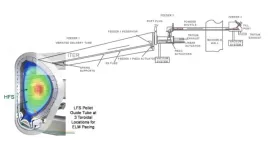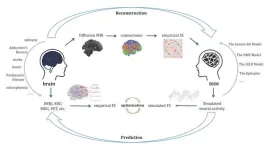A blood test, performed when metastatic prostate cancer is first diagnosed, can predict which patients are likely to respond to treatment and survive the longest. It can help providers decide which patients should receive standard treatment versus who might stand to benefit from riskier, more aggressive new drug trials. The research, part of a phase 3 clinical trial funded in part by the National Cancer Institute (NCI) of the National Institutes of Health, was just published in JAMA Network Open.
Before it spreads, prostate cancer can be cured with surgery or radiation. Once the cancer has metastasized and is no longer curable, systemic treatments are used to prolong survival as much as possible. Biomarkers that predict how patients will respond could allow for better personalization of treatments, but they are few and far between.
A new study found that measuring circulating tumor cells (CTCs), rare cancer cells shed from tumors into the blood, is a reliable way to predict later treatment response and survival prospects. CTCs have been studied in prostate cancer before, but only in its later stages.
“No one, until now, has looked at whether CTC counts can be used right at the beginning, when a man first presents with metastatic prostate cancer, to tell us whether he’s going to live a long or short time, or whether or not he will progress with therapies,” said Amir Goldkorn, MD, lead author of the study and associate director of translational sciences at the USC Norris Comprehensive Cancer Center at the Keck School of Medicine of USC.
The research leveraged CellSearch (Menarini, Inc.), an FDA-cleared liquid biopsy technology at the Norris Comprehensive Cancer Center, to detect and measure CTCs in blood samples. Patients with more CTCs had shorter median survival lengths and a greater risk of death during the study period. Those with more CTCs also had less “progression-free survival,” which refers to the length of time when a patient’s disease is controlled by treatment without getting worse.
“You couldn’t tell these men apart when they walked through the door,” said Goldkorn, who is also a professor of medicine at the Keck School of Medicine. “All of their other variables and prognostic factors were seemingly the same, and yet they had very, very different outcomes over time.”
The researchers say that the CellSearch blood test, which is already widely available from commercial providers, can help quickly identify patients who are unlikely to respond to standard treatment options. Those men could benefit from a more intensive approach to therapy, including clinical trials of new drugs that may have more side effects but could improve survival in these high-risk patients.
Counting CTCs
The research was part of a phase 3 clinical trial of the NCI-funded SWOG Cancer Research Network, a group of more than 1,300 institutions around the country that collaborate to study various cancers. Baseline blood samples from 503 patients with metastatic prostate cancer, who were participating in a new drug trial, were sent to the Keck School of Medicine team for analysis.
To analyze the blood samples, the researchers used the CellSearch platform at the Norris Comprehensive Cancer Center’s Liquid Biopsy Research Core, a facility that Goldkorn founded and directs. CellSearch uses immunomagnetic beads, antibodies attached to small magnetic particles, which bind to CTCs in the blood and pull them out to be detected and counted by specialized equipment.
Patients with five or more CTCs in their blood sample had the worst outcomes. Compared to patients with zero CTCs, they were 3.22 times as likely to die during the study period and 2.46 times as likely to have their cancer progress. They were only 0.26 times as likely to achieve a complete prostate-specific antigen (PSA) response, meaning they responded poorly to treatment.
Men with five or more CTCs had a median survival length of 27.9 months following the blood test, compared to 56.2 months for men with one to four CTCs and at least 78 months for men with zero CTCs. (Many patients in the latter group survived past the date of publication, so the median survival length could not yet be calculated.)
The bottom line: more CTCs meant that patients survived for less time, progressed much more quickly and were unlikely to respond to standard treatments.
Candidates for clinical trials
The new study shows that measuring CTC counts at the start of therapy can predict long-term survival rates, even in men who go on to receive many treatments for metastatic prostate cancer over a years-long period. That means the test can help identify men early on for trials of new and potentially more aggressive therapies.
“We want to enrich these clinical trials with men who need all that extra help—who really would benefit from three drugs versus just two, or from being on a new chemotherapy drug, even though it may have more side effects,” Goldkorn said.
Goldkorn and his team are now testing a new blood test that measures not just CTC counts, but also the molecular composition of CTCs and tumor DNA circulating in the blood, as well as other factors. Their goal is to create biomarkers with even more predictive power, which may ultimately help match patients with specific treatment options.
About this research
In addition to Goldkorn, the study’s other authors are Daniel Bsteh, Tong Xu, Jacek K. Pinski, David I. Quinn and Sue Ingles from the Keck School of Medicine of USC and the Norris Comprehensive Cancer Center, University of Southern California; Timothy Junius Triche from USC Children’s Hospital Los Angeles; Catherine Tangen and Melissa Plets from the SWOG Statistical Center, Fred Hutchinson Cancer Center, Seattle, Washington; Gary R. MacVicar from Illinois CancerCare PC, Peoria, Illinois; Daniel A. Vaena from University of Iowa Hospitals and Clinics, Holden Comprehensive Cancer Center, Iowa City, Iowa; Anthony W. Crispino from UsTOO Las Vegas, Las Vegas, Nevada; David James McConkey from Johns Hopkins Greenberg Bladder Cancer Institute, Baltimore, Maryland; Primo N Lara Jr. from the University of California Davis Comprehensive Cancer Center, Sacramento, California; Maha H. A. Hussain from the Feinberg School of Medicine, Northwestern University, Chicago, Illinois; Tanya B. Dorff from the City of Hope Comprehensive Cancer Center, Duarte, California; Seth Paul Lerner from the Dan L. Duncan Cancer Center, Baylor College of Medicine, Houston, Texas; Ian Thompson Jr. from Christus Health, San Antonio, Texas; and Neeraj Agarwal from the Huntsman Cancer Institute (NCI-CCC), University of Utah, Salt Lake City, Utah.
This work was supported by the National Cancer Institute of the National Institutes of Health [CA172436, CA180888 and CA180819] and Millennium Pharmaceuticals (Takeda
END





